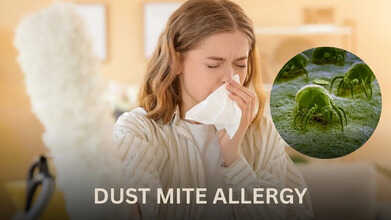- Health Conditions A-Z
- Health & Wellness
- Nutrition
- Fitness
- Health News
- Ayurveda
- Videos
- Medicine A-Z
- Parenting
- Web Stories
Fact Check: Does Age Really Lower Your Fertility? Here’s What Experts Say

Credits: Canva
More Americans are waiting longer than ever to start families. In fact, birth rates among women in their early 30s have surpassed those of women in their late 20s for the seventh straight year in 2022. The number of births among women aged 40 and older is also on the rise, government data shows.
This trend challenges the long-held belief that getting pregnant becomes nearly impossible or too risky with age. However, fertility specialists say the truth is more layered. To understand it better, we spoke with Dr. Akta Bajaj, Obstetrics & Gynaecology, Ujala Cygnus Group of Hospitals, who helped clear up some of the biggest misconceptions.
Can Age Really Affect Your Fertility?
For many years, experts have blamed declining egg quality as the main reason for reduced fertility with age. But new findings from UC San Francisco and the Chan Zuckerberg Biohub San Francisco suggest that there’s more to it. The study, supported by the National Institutes of Health (NIH), reveals that the cells and tissues surrounding the egg also play a major role in how eggs mature and how fast fertility declines.
According to Dr. Randi Goldman, Program Director of Reproductive Endocrinology and Infertility at Northwell, while fertility naturally drops with age, it’s a gradual change rather than a sudden one. Many women in their 30s are still capable of conceiving without assistance. Data shows that the odds of pregnancy in a single menstrual cycle are around 25% for women in their 20s, about 20% by age 30, and roughly 15% by age 35 — which Dr. Goldman notes is still quite reasonable.
Myths Around Age and Fertility
Dr Bajaj told us that fertility comes with its own set of facts and myths, and she told us some myths around fertility that everyone should note:
Myth 1: Fertility Declines Only After 35
Fact: Fertility doesn’t suddenly drop at 35, it starts to dip slowly in the late 20s and early 30s. By the mid-30s, this decline becomes more noticeable, and after 37, it tends to speed up. While chances of conception decrease gradually, many women in their 30s still conceive naturally and have healthy pregnancies. It may take a little longer, but it’s often still achievable.
Myth 2: Modern Medicine Can Reverse Age-Related Fertility Decline
Fact: Treatments like IVF can improve the chances of pregnancy but can’t completely undo the effects of aging. As a woman ages, egg quality drops, which affects embryo growth and lowers IVF success rates. IVF relies on a woman’s own eggs, and if those eggs are older, embryos may not develop as well. Donor eggs can increase success rates, but no medical procedure can reverse the natural aging of the ovaries.
Myth 3: Men’s Age Doesn’t Matter
Fact: Men also experience age-related fertility changes, though more slowly. Sperm count, movement, and DNA quality begin to decline after 40, which can make conception harder and slightly raise the risk of miscarriage or certain developmental disorders. The risk remains small but becomes more visible as men get older.
Myth 4: You Can Always Freeze Eggs and Conceive Later
Fact: Egg freezing gives women flexibility but is not a guaranteed path to pregnancy. Success largely depends on the age at which eggs are frozen. The ideal time is before 35 when eggs are typically healthier. Freezing eggs at an older age can result in fewer viable embryos and lower chances of success. It’s a helpful option, but not a sure solution.
Myth 5: If You’re Healthy, Age Doesn’t Matter
Fact: Good health supports fertility but can’t completely overcome the effects of aging. Regular exercise, nutritious eating, and avoiding smoking or heavy drinking can help reproductive health, but they don’t stop the biological changes that occur in eggs and sperm as we age.
In short, while age does play a role in fertility, it doesn’t mean pregnancy is impossible after your 30s. Experts agree that understanding your body and seeking timely guidance can make all the difference when planning parenthood later in life.
What Is A Polygenic Score And How It Could Reveal Your Future Breast Cancer Risk?

Credits: Canva
Breast cancer is the most frequently diagnosed cancer in women, accounting for over 15% of all new cancer cases in the United States. Abnormal cell growth in the breast ducts (DCIS) or lobules (LCIS) can sometimes progress to breast cancer, but currently, doctors cannot predict which cases will develop into invasive cancer.
A recent retrospective study using the 313-SNP breast cancer polygenic risk score (PRS313) blood test suggests that women with abnormal cells are more likely to be diagnosed with breast cancer later on. This discovery could help identify patients who would benefit from targeted interventions while reducing unnecessary treatments.
Although DCIS and LCIS can progress to breast cancer, predicting which cases will remain harmless has been a challenge. However, this new study indicates that calculating a polygenic score may help forecast a future breast cancer diagnosis.
“It is therefore very important that we find ways to predict which women with DCIS and LCIS are most likely to develop invasive breast cancer in the future so they can be given the most appropriate treatment and avoid unnecessary treatment,” explained study senior author Elinor J. Sawyer of King’s College London (UK).
What Is A Polygenic Score?
A polygenic score is a numerical estimate of a person’s genetic likelihood of developing a particular trait or disease. When used to predict disease risk, it is often called a polygenic risk score (PRS), according to Harvard Medicine Magazine.
Sawyer and study lead author Jasmine Timbres (King’s College London) focused on PRS313, a blood test that evaluates breast cancer risk by identifying which of 313 specific genetic variations (single nucleotide polymorphisms, or SNPs) a person carries. The researchers examined PRS313 scores from more than 2,000 DCIS and LCIS cases across the ICICLE and GLACIER studies.
Their findings showed that, for DCIS, women with higher PRS313 scores were 2.03 times more likely to develop cancer in the opposite breast compared to those in the lowest score quartile. For LCIS, women with elevated PRS313 scores were 2.16 times more likely to develop cancer in the same breast. The risk was even higher for patients with a family history of breast cancer.
“LCIS is not always treated with surgery or hormone therapy because it is considered lower risk than DCIS. However, these results suggest that women with a family history may benefit from additional interventions to reduce their risk of developing cancer,” Timbres added.
How To Measure A Polygenic Score?
A polygenic score is calculated by looking at an individual’s genetic variations (like SNPs) and summing them with weights based on how strongly each variant is associated with a trait or disease, as determined by large-scale genome-wide association studies (GWAS). Researchers first identify genetic variants linked to a disease by comparing the genomes of people with and without the condition. Each variant’s effect size is then applied to the individual’s genome to create a single score representing their overall genetic risk.
Polygenic scores can be measured in research settings using GWAS data. They are also available through commercial direct-to-consumer genetic testing services or via clinical assessments provided by medical institutions and genetic counselors.
Limitations Of The Study
While these findings are promising, further research is needed to confirm results in other patient groups and to examine additional genetic factors. Some limitations include the fact that PRS313 was designed specifically to assess risk for invasive breast cancer, meaning it may not capture other relevant genetic changes in in-situ breast disease. Additionally, the number of women with LCIS in the study was relatively small, which may have limited the ability to detect statistically significant associations.
Deep Cleaning On Diwali Can Lead To Dust Mite Allergy; Here's How To Stay Safe

Credits: Canva
When Diwali comes near, every Indian household gets into full cleaning mode. The week leading up to the festival is usually spent sweeping, scrubbing, and dusting every corner of the home. While this ritual is believed to invite prosperity, it can also have some hidden problem, dust mite allergy.
If you start sneezing uncontrollably, coughing, or notice a runny nose while cleaning, chances are you are reacting to dust mites. But how serious can this allergy get? Let’s understand.
What Is Dust Mite Allergy?
Dust mite allergy, also called house dust allergy, happens when your immune system becomes sensitive to the droppings and remains of microscopic dust mites. These tiny, spider-like organisms live in bedding, mattresses, carpets, curtains, and furniture, feeding on dead skin cells shed by humans and pets.
According to the Cleveland Clinic, dust mite waste and dead bodies contain certain proteins that act as allergens. While these proteins are harmless to most people, some immune systems mistake them for dangerous invaders and trigger allergic reactions such as sneezing, asthma, itching, or eczema.
Can Dust Mite Allergy Trigger More Chronic Diseases?
Yes, a dust mite allergy can worsen over time and contribute to chronic conditions. The National Institutes of Health states that long-term exposure can lead to diseases like asthma and chronic sinusitis due to persistent inflammation.
Here are some chronic diseases linked to dust mite allergy:
- Asthma: Dust mite allergens are one of the main causes of asthma and can provoke severe attacks. Ongoing inflammation may make the airways overly sensitive and lead to permanent changes in lung tissue.
- Chronic sinusitis: Continuous exposure can inflame and swell the nasal passages, resulting in long-term sinus blockage and infections.
- Atopic dermatitis (Eczema): Though not a chronic disease itself, eczema can be made worse by dust mites, causing persistent irritation.
Why it can lead to chronic disease:
- Chronic inflammation: The immune system’s response to dust mites inflames the nasal passages and lungs. Prolonged exposure keeps this inflammation active, gradually damaging tissues.
- Increased sensitivity: Constant inflammation heightens sensitivity to smoke, pollution, or dry air, making symptoms more intense.
- The “atopic march”: This term describes the way allergic conditions can evolve, for example, eczema in childhood developing into asthma or allergic rhinitis later, often linked to dust mite sensitivity.
How Can Dust Mite Allergy Affect Your Body?
When your body first encounters dust mite proteins, it creates antibodies known as immunoglobulin E (IgE) to attack what it perceives as harmful allergens. On later exposure, your immune system reacts more strongly, releasing chemicals that trigger symptoms such as sneezing, itching, or congestion.
How To Treat Dust Mite Allergy: How To Stay Safe
The most effective way to manage a dust mite allergy is by reducing your exposure to dust mites. While it is impossible to remove them completely, minimizing contact helps prevent severe reactions. If symptoms appear, consult a doctor for the right medication. Those with asthma, sinusitis, or other chronic respiratory issues should avoid heavy cleaning during Diwali.
Here are some common treatment options available to treat dust-mite allergy. However, please note that you should take these only under the guidance of a medical professional:
- Antihistamines: Help control sneezing, itching, and watery eyes.
- Nasal corticosteroid sprays: Reduce inflammation and ease congestion.
How To Manage Dust Mites While Cleaning For Diwali
A few steps can help control dust mites while keeping your home festive and clean:
- Use an air conditioner or dehumidifier to keep humidity in check.
- Install a high-efficiency particulate air (HEPA) filter.
- Choose washable decorations and clean them regularly.
- Dust using a damp or oiled cloth instead of a dry one.
- Vacuum frequently with a vacuum cleaner that has a HEPA filter.
- Declutter your space to reduce dust buildup.
- Wash curtains and clean upholstered furniture often.
- If possible, replace carpets with wood, tile, vinyl, or linoleum flooring.
US Measles Outbreak: South Carolina Reports A Rise In The Numbers Of Cases, Can Low Vaccination Rates Be The Reason Behind?

(Credit-Canva)
Recently the US has seen a rise in the numbers of measles cases, with outbreaks being recorded in states like Texas and South Colorina. According to the South Carolina Department of Health, the measles outbreak there as reached 16 confirmed cases, according to an October 14 announcement from state health officials. This figure includes five new cases linked to students exposed in school settings, specifically at two schools with significantly low vaccination rates.
The highly contagious viral disease was first identified in the state's Upstate region in early October by the South Carolina Department of Health. The majority of cases, a dozen, are concentrated in Spartanburg County.
What Is The Reason Behind The Rise In Measles Cases?
The South Carolina Department of Health found the highly contagious virus in the Upstate region earlier in October. Most cases, 12 of them, are in Spartanburg County. Because of this, nearly 140 unvaccinated students from two elementary schools are now staying home to prevent the spread.
The five new cases were students who were already isolating at home after being exposed at school. The exposures happened at two Spartanburg County schools with very few vaccinated students: Global Academy of South Carolina and Fairforest Elementary School according to media reports.
- Global Academy, a charter school with over 600 students, reported that only 17% of students had their required shots. Experts say 95% are needed to protect the community.
- Fairforest Elementary, a public school with over 760 students, had a slightly better rate of 85%.
Officials are worried because some people who got sick were not in contact with known cases or travelers. This suggests the measles virus is spreading easily in the community and could get worse. The state plans to offer free vaccines to help stop the spread.
Is There A Decline In The Vaccination Rates?
Low vaccination rates are causing problems across the entire country. In 2025, the U.S. has seen a record of over 1,500 measles cases in 44 different outbreaks. Most of the people who got sick were not vaccinated.
The U.S. got rid of measles in 2000, meaning new cases only came from people traveling from other countries. However, because more parents are choosing not to give their children the required vaccines, the disease has come back strongly.
Measles spreads when an infected person coughs or sneezes. The air can stay contaminated for up to two hours. Symptoms, which appear one to two weeks later, include high fever, cough, runny nose, and red eyes, followed a few days later by a red rash.
Vaccines are excellent at preventing the disease. Getting the full two-dose shot (called MMR) gives 99% protection against measles and rubella, according to the National Health Services UK. They also mention how two doses also protect 88% of people against mumps. It is usually given around a child’s first birthday and again between ages 4 and 6.
Measles can be very dangerous. About 1 in 5 people who get it will need to go to the hospital. It can cause serious problems like pneumonia, which is a major cause of death in sick children or brain swelling, which can lead to deafness or other long-term disabilities.
© 2024 Bennett, Coleman & Company Limited

